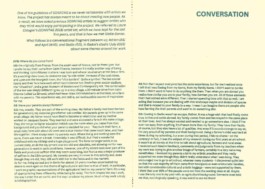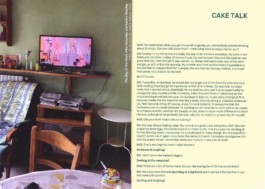The Day of the Week after Saturday and before Monday
Site-specific Installation, 2023
Silkscreen, free-motion embroidery on plastic table cloth, video (loop 42 min), sound installation

This site-specific installation* approaches the theme of labor through the meaning of Sundays - the day when activities are supposedly quieter, slower and more relaxing, the day family and friends come to visit or the day when things have to be out of the ordinary and fun. It’s still a day of work for others, imposed or desired, those whose job it is to care for others, to do domestic work and to offer entertainment services.
The Day of the Week after Saturday and before Monday proposes a soft play with the attention span in domestic space. It’s composed of elements evoking the life on my family farm and the world of my parents’ kitchen - the central room of the house that doubles as a living room; television makes its presence felt by being switched on almost constantly throughout the day. On Sundays, it broadcasts religious channels on public television in the morning and sports channels in the afternoon. Opposite it, the wooden table is protected by a plastic tablecloth, ready to receive the various dishes prepared by my mother. The kitchen has 2 entrances, each with a separate doorbell, that regularly rings when they try to take a nap in their armchairs. These elements have been distorted, amplified or, as in the case of the video montage, queered.
*Site-specific Installation for the event series Sonntag, curated by April Gertler and Adrian Schiesser Sunday, 17 September 2023 at Scharnweberstr. 50, Berlin
Sonntag is a nomadic project space taking place on Sundays in private apartments in Berlin, Germany.

Installation view, Sonntag, 2023
The footage for the video montage was collected from various online sources, focusing on the representation of LGBTQA+ icons, female or non-binary athletes or runners. The selection and editing process was a way of queering the footage to make the sports channels look like I would have wanted them to look as a queer person growing up in the country.






from top to bottom, from left to right, video stills from different internet footage:
FIFA Women’s World Cup France 2019 FINAL _ USA v Netherlands _Megan Rapinoe is an advocate for numerous LGBTQIA+ organizations / 2020 European Road Cycling Championships _ Elite Women
2008 Firestone IndyCar 300 at Japan, Danica Patrick is the most successful woman in the history of American open-wheel car racing—her victory in the 2008 Indy Japan 300 is the only win by a woman in an IndyCar Series race. / Michèle Mouton is a former French rally driver, and is best known as the first (and only) woman to ever win a round of the World Rally Championship (WRC).
France Race Highlights _ 2022 W Series (W Series was an all-female single-seater racing championship, stopped because of no sponsorship appeared) /FIFA Women’s World Cup France 2019 FINAL _ USA v Netherlands _

The silkscreen image on the napkins is an analogue photograph of a milking parlour from my series about young farmers in the village where I grew up. Although Sunday was supposed to be a day off work, my father still had to go to the milking parlour twice a day to milk the cows, once in the morning and once in the evening. The cows didn’t stop producing on Sundays either. The fabrics were cut and sewn from old sheets coming from my parents’ farm.
Silkscreen on upcycled fabrics, limited edition, 33 x 33 cm, and detail, 2023
The same milking parlour motif was partly embroidered on the plastic table cloth.


Table cloth, free-motion embroidery, 300 x 140 cm, details, 2023
The Day of the Week after Saturday and before Monday features a sound piece. It’s composed of two asynchronous clocks hung on opposite walls, the sound of their hands has been amplified. One of the clocks chimes every hour with the song of a new bird. The atmosphere is as if the room were empty and silence reigned, interrupted only by the sound of seconds ticking away and the heaviness of time passing.


Installation view, clocks with sound amplifier, Sonntag, 2023
Publication excerpt, SONNTAG BULLETIN # 3, Fall 2023
Produced and published by WIRWIR Publishes in Berlin - Neukölln




The Day of the Week after Saturday and before Monday
Site-specific Installation, 2023
Silkscreen, free-motion embroidery on plastic table cloth, video (loop 42 min), sound installation

This site-specific installation* approaches the theme of labor through the meaning of Sundays - the day when activities are supposedly quieter, slower and more relaxing, the day family and friends come to visit or the day when things have to be out of the ordinary and fun. It’s still a day of work for others, imposed or desired, those whose job it is to care for others, to do domestic work and to offer entertainment services.
The Day of the Week after Saturday and before Monday proposes a soft play with the attention span in domestic space. It’s composed of elements evoking the life on my family farm and the world of my parents’ kitchen - the central room of the house that doubles as a living room; television makes its presence felt by being switched on almost constantly throughout the day. On Sundays, it broadcasts religious channels on public television in the morning and sports channels in the afternoon. Opposite it, the wooden table is protected by a plastic tablecloth, ready to receive the various dishes prepared by my mother. The kitchen has 2 entrances, each with a separate doorbell, that regularly rings when they try to take a nap in their armchairs. These elements have been distorted, amplified or, as in the case of the video montage, queered.
*Site-specific Installation for the event series Sonntag, curated by April Gertler and Adrian Schiesser Sunday, 17 September 2023 at Scharnweberstr. 50, Berlin
Sonntag is a nomadic project space taking place on Sundays in private apartments in Berlin, Germany.

Installation view, Sonntag, 2023
The footage for the video montage was collected from various online sources, focusing on the representation of LGBTQA+ icons, female or non-binary athletes or runners. The selection and editing process was a way of queering the footage to make the sports channels look like I would have wanted them to look as a queer person growing up in the country.






from top to bottom, from left to right, video stills from different internet footage:
FIFA Women’s World Cup France 2019 FINAL _ USA v Netherlands _Megan Rapinoe is an advocate for numerous LGBTQIA+ organizations / 2020 European Road Cycling Championships _ Elite Women
2008 Firestone IndyCar 300 at Japan, Danica Patrick is the most successful woman in the history of American open-wheel car racing—her victory in the 2008 Indy Japan 300 is the only win by a woman in an IndyCar Series race. / Michèle Mouton is a former French rally driver, and is best known as the first (and only) woman to ever win a round of the World Rally Championship (WRC).
France Race Highlights _ 2022 W Series (W Series was an all-female single-seater racing championship, stopped because of no sponsorship appeared) /FIFA Women’s World Cup France 2019 FINAL _ USA v Netherlands _

The silkscreen image on the napkins is an analogue photograph of a milking parlour from my series about young farmers in the village where I grew up. Although Sunday was supposed to be a day off work, my father still had to go to the milking parlour twice a day to milk the cows, once in the morning and once in the evening. The cows didn’t stop producing on Sundays either. The fabrics were cut and sewn from old sheets coming from my parents’ farm.
Silkscreen on upcycled fabrics, limited edition, 33 x 33 cm, and detail, 2023
The same milking parlour motif was partly embroidered on the plastic table cloth.


Table cloth, free-motion embroidery, 300 x 140 cm, details, 2023
The Day of the Week after Saturday and before Monday features a sound piece. It’s composed of two asynchronous clocks hung on opposite walls, the sound of their hands has been amplified. One of the clocks chimes every hour with the song of a new bird. The atmosphere is as if the room were empty and silence reigned, interrupted only by the sound of seconds ticking away and the heaviness of time passing.


Installation view, clocks with sound amplifier, Sonntag, 2023





